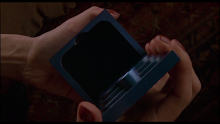
But why do the Martians decide to invade our little planet? The film opens with a classic “docudrama” explaining the circumstances of the invasion.
The prelude shows images from the First and Second World Wars explaining the fatal evolution of destruction methods on Earth. A rocket launch evokes the ultimate power of destruction: the threat comes from outer space!
The spectators discover the Blue Planet, through the zoom-in lens of the Martians’ spying device.




The prelude shows images from the First and Second World Wars explaining the fatal evolution of destruction methods on Earth. A rocket launch evokes the ultimate power of destruction: the threat comes from outer space!
The spectators discover the Blue Planet, through the zoom-in lens of the Martians’ spying device.



What a sky! This colorful field of yellow, red and blue stars is the vision of an artist, a creator of worlds, who, in this scene, takes the place of the director. These painted canvases are the masterpieces of one of the founding fathers of “astronomical art” (art which is still used today to illustrate some of NASA’s projects): Chesley Bonestell.

A guided visit of our solar system :

Chesley Bonestell was Georges Méliès’ contemporary ! Born in 1888, he creates his first « astronomical painting » at the age of 17 in 1905, after seeing Saturn through the telescope of the Observatory in San José, California. He becomes a “matte artist” in Hollywood during the 1940s.
Let’s take that obscure word from the Black Box and take a closer look : « matte » is a « mask ». “Matte painting” is a “cinematographic procedure which consists in painting a set leaving empty spaces in which one or several filmed scenes are incorporated.” This process helps create the illusion of depth of field and serves as a base for several special effects.
Chesley Bonestell is the creator of the “background paintings” for Orson Welles’ first movies: Citizen Kane and The Magnificent Ambersons. He collaborates with the artistic department in The War of the Worlds. His decors for the set of this movie are real masterpieces.
Let’s take that obscure word from the Black Box and take a closer look : « matte » is a « mask ». “Matte painting” is a “cinematographic procedure which consists in painting a set leaving empty spaces in which one or several filmed scenes are incorporated.” This process helps create the illusion of depth of field and serves as a base for several special effects.
Chesley Bonestell is the creator of the “background paintings” for Orson Welles’ first movies: Citizen Kane and The Magnificent Ambersons. He collaborates with the artistic department in The War of the Worlds. His decors for the set of this movie are real masterpieces.
A guided visit of our solar system :

This is Mars, inhabited but threatened by mass destruction. The inhabitants look for another planet to continue living. The composition of shots we find on the other paintings accentuates depth of field.
Pluto… the same field of multicolored stars.
 Saturn. Its rings…
Saturn. Its rings…
 And its improbable clouds making their way across the frame.
And its improbable clouds making their way across the frame.  Jupiter.
Jupiter. Mercury.
Mercury.  And finally, the ideal destination: Planet Earth.
And finally, the ideal destination: Planet Earth. Filmed in 1953, The War of the Worlds uses the methods of the time: matte paintings, zoom and travelling over the paintings to give the impression of a learned tour around our solar system. The “naïveté” of the special effects places this film under the “spectacular cinema” tradition.
The « docudrama » of the prologue is not a narrative. It doesn’t tell the story of what happens over our earthling heads. We can only see the Martians’ view over the Earth. The cosmos is the artist’s view, a painted surface; not yet a glance : a vision.







ghd hair straighteners
RépondreSupprimermichael kors factory outlet
ralph lauren uk
football shirts
tory burch outlet
michael kors factory outlet
pandora jewelry
basketball shoes
barbour coats
replica handbags
north face jackets
nfl jerseys wholesale
ugg boots
michael kors outlet
moncler jackets
michael kors handbags
ugg boots
michael kors outlet store
canada goose outlet
asics
canada goose coats
the north face outlet
cheap oakley sunglasses
cheap nba jerseys
canada goose outlet
oakley sunglasses
longchamp handbags
hermes belt
cheap nfl jerseys
oakley
ugg australia
snow boots
the north face outlet store
soccer jerseys
timberland boots
the north face uk
oakley sunglasses
barbour coats
true religion jeans
rolex watches
cai20151024